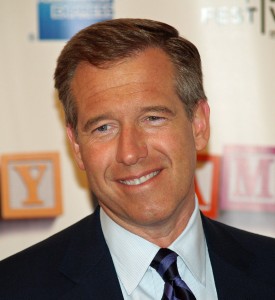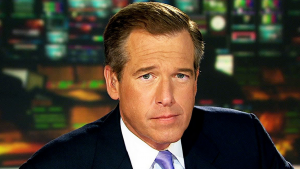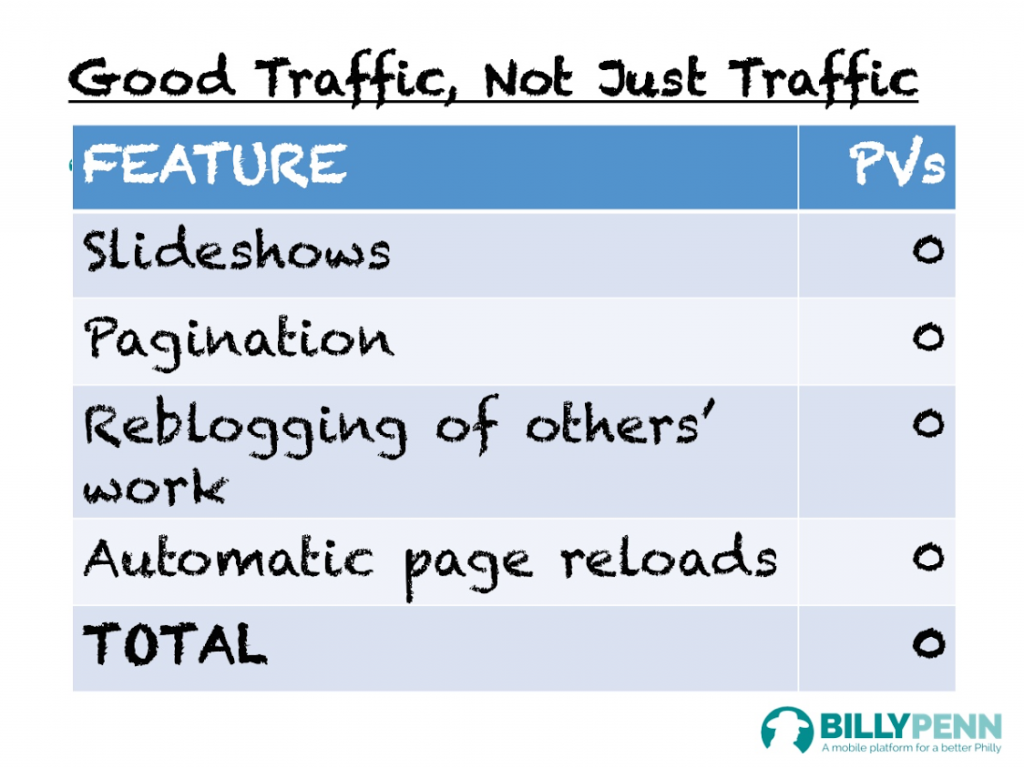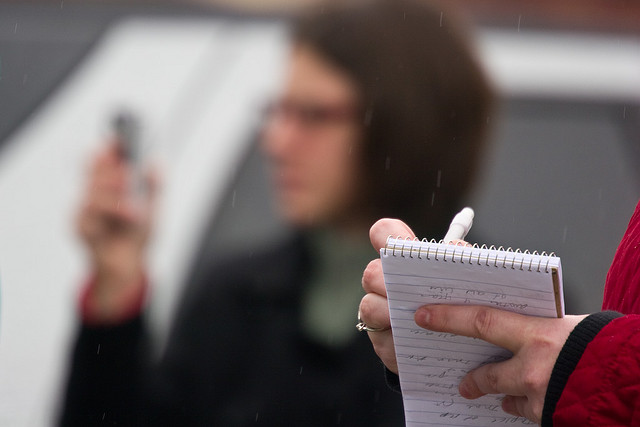A disgusted viewer and longtime critic of the Sunday shows — that would be me — interviews NBC’s Chuck Todd about his attempt to remake the most famous of those shows.
1. PressThink: You told Breitbart that your interview with them was “a step in the rehabilitation of my business… Talk to the critics. Talk to the skeptics.” We’ll get to the other steps in that rehabilitation later, but what’s the thinking behind this step? What are you hoping will happen if you do “talk to the critics, talk to the skeptics?”
![Meet the Press - Season 67]() Chuck Todd: I think there are too many folks in my business who are too defensive and desperately hope things return to the so-called “good old days.” The media landscape has changed. We need to adapt. We need to acknowledge new players. When I say it’s time to talk to the critics and the skeptics, it means engaging, hearing new ideas. Perhaps incorporating some or dismissing some but at least explaining why. Have the two-way conversation. A lot of media critics don’t know what happens behind the scenes and sometimes that does matter. For instance, just because we don’t air a story, doesn’t mean we didn’t report it out. Just didn’t deem it worth airing.
Chuck Todd: I think there are too many folks in my business who are too defensive and desperately hope things return to the so-called “good old days.” The media landscape has changed. We need to adapt. We need to acknowledge new players. When I say it’s time to talk to the critics and the skeptics, it means engaging, hearing new ideas. Perhaps incorporating some or dismissing some but at least explaining why. Have the two-way conversation. A lot of media critics don’t know what happens behind the scenes and sometimes that does matter. For instance, just because we don’t air a story, doesn’t mean we didn’t report it out. Just didn’t deem it worth airing.
2. PressThink: You mean the “good old days” of one-way media without a lot of choice for the users?
Chuck Todd: Exactly. Look, I have an incredible platform, I get that. But that doesn’t mean we are the only game in town. We have to acknowledge the entire landscape, maybe even change how we report. For instance, in the “good old days,” not reporting a story that didn’t pan out was enough to make sure an untrue story didn’t make it into the eco-system. Now, there are a number of ways untrue stories can go public. We in the so-called MSM should be willing to report what is not true, rather than ignoring and claiming that “well, we didn’t deem it worthy” and therefore don’t have a responsibility for debunking someone else’s rumor. I’m not sure we can defend not sharing publicly what we know is true and false.
3. PressThink: Would you agree with me that “he said, she said” reporting (and “he said, she said” roundtables!) have been a disaster for public confidence in the press?
Chuck Todd: Of course. I think there is no such thing as “fair and balanced.” It’s simply “fair.” As for whether it is a disaster? I think the disaster is how the politicians play into this. It’s a two-way street. My philosophy is trying to make sure different perspectives are represented when it comes to opinion about the political landscape, but this should not get in the way of facts.
4. PressThink: The words are said to be Daniel Patrick Moynihan’s, “You have a right to your own opinion. You do not have a right to your own facts.” But if there’s one place on the dial where it seems that important people do have a right to their own facts, it’s the Sunday morning talk shows. How did that happen? Where did it go wrong? What was the fatal moment or crossing point?
Chuck Todd: Where to begin. I think the advent of advocacy TV interviewers being available helped accelerate this a bit. Then you have the coordinated campaigns on the left and right to pressure news organizations on balance. And too many executives in general felt the heat enough to then decide “make everything he said, she said” because it was deemed politically safe. Realize: there is an industry out there that feels their job is to try and create doubt about the MSM with partisans, and it really is a business decision in order to drive folks to their own POV programming.
I think there are some true disagreements over facts that we shouldn’t pretend don’t exist. For instance, when it comes to tax policy, the disagreement on facts comes from assumptions about consumer behavior that can change over time and not be something you can pin down as factually accurate. And let me add one more thing. As for the change on Sundays over time, I think the overall pressure from cable when cable went daily with political discussions pushed folks in charge of Sunday shows to emulate cable.
5. PressThink: Which is how Jon Stewart became your most effective critic. His show is essentially about the excesses and stupidity of the cable news formula.
Chuck Todd: Cable news has become an easy target, that’s for sure. I prided myself on how little my cable show ended up as an example. Of course, you don’t get credit for that.
6. PressThink: You said this to the Daily Beast:
I think there is this perception that the American public has about Washington right now—and they’ve thrown all of us in the media with it—that we’re out of touch. We don’t understand what’s going on. We’re all caught up in the process of the Acela Corridor. Being in Washington, we’re not experiencing what the folks ‘between the Fives’ are experiencing. We got caught up in that Washington-New York mind-set.
From what I can tell by doing my homework and by watching the show you have four answers to this problem:
One is: you’re not a Washington insider yourself, by background at least. Middle class kid from Miami, not a creature of the Acela corridor. “I’ve got my own kitchen cabinet of relatives who’ve had to live through some of the hard realities of this recession,” you have said.
Second answer: Political journalists can regain credibility by showing that they “get it,” which for you means listening to people beyond the Fives (Interstate 95 on the East Coast, I-5 in California) and then translating — that’s the key word for you, translating — their anxiety and frustration into tough questions for public officials.
A third answer is to hear more often from people involved in politics “out there” between the Fives, who are not close at hand in Washington, as with your conversation with three mayors from other cities about what’s working elsewhere.
Fourth answer: Diversify the guest list. No more “elected pundits,” office holders who are simply repeating what they read on the op-ed page. Broaden the mix, as with John Stanton of Buzzfeed or Thomas Frank, author of What’s the Matter with Kansas.
So I have several questions about the Chuck Todd plan to restore trust in Sunday morning political television. First. What did I miss?
Chuck Todd: You have done your homework. Relevancy— that’s the only other thing I’d add. Try to make sure we’re relevant to what the country should be understanding about what’s going on.
7. PressThink: How do you think political journalism, your profession, became over-identified with the politicians and insiders themselves? You’ve said that voters and viewers now lump you and your colleagues in with the people who have made a mess of politics. How did that happen?
Chuck Todd: The one-two punch of the Iraq War and the recession. Basically two huge things that the folks in charge blew and we in “the media” appeared to go along in only explaining the government’s side of “why.” So Iraq started eroding trust, then the recession nearly finished the job on trust erosion, thanks to the glorification of Wall Street by the media in general over the ’90s and early 21st century. Toss in the fact that we in the media lived in the two areas of the country that did not experience the recession, and it’s a toxic stew. Since the folks who were at fault never got punished, the media didn’t appear to be on the public’s side, but instead looked to be collectively on the side of the elites.
8. PressThink: So if I understand that answer, smart people in political journalism should have realized that the near total lack of accountability for these huge disasters was going to come back on them, that they weren’t doing enough to perform in the watchdog role they hold out for themselves. Is that a fair summary?
Chuck Todd: Yes. And let me stipulate, perhaps it is easy for me to backseat drive. I wasn’t covering the White House at the time. I was covering the political landscape, covering elections for a trade publication, then behind the scenes here [at NBC News] doing similar work. I’d like to think that when given the opportunity, I would have been more skeptical; but sometimes for beat reporters, seeing the forest can be difficult, no matter how hard you try. I now have an opportunity to constantly be the person that is hopefully seeing the forest too.
9. PressThink: I would remind you that your predecessor, David Gregory, said several times that he thought the press did a fine job in the run-up to the Iraq War, that all the important questions were asked, that criticism including Washington journalists in the list of institutions that failed is misplaced. I found that astonishing, that he would continue to say that in retrospect. Did you?
Chuck Todd: He was a daily beat reporter. I’m sure he and others did ask plenty of skeptical questions. But that skepticism didn’t always make it on air or in print and then I don’t know how editors and producers were treating those questions once the reporters made it on air or in print. It’s not an excuse, just explaining that there is a way for both things to be true.
Let’s also remember, this doesn’t happen without a slew of political leaders all marching to the same drum, all using the same sources to justify their positions. But this is where the anger at the press began. We’re mad that the politicians lied or misled us either on purpose or accident. But sadly, maybe the public expects politicians to lie or mislead. What they want is a press corps to help them hold these folks accountable, especially after the fact.
10. PressThink: I have been a faithful viewer of the Sunday shows for more than 20 years, and I felt my own frustration grow during that span. One thing that jumps out at me as a critic who switches among them is the unbelievable uniformity of these shows, not only in basic format but in the guest list, the questions, the topics. When Fox and CNN entered this derby with Chris Wallace and Candy Crowley, their shows were almost carbon copies of Meet the Press, Face the Nation, and This Week on ABC. It’s like a single mind is producing them, but it has 50 pairs of feet. If you’re going to change that, it seems to me the first step is to figure out: how does that happen, that kind of group think. So why do you think it happened?
Chuck Todd: Well, TV has a history of copying what works. When CNN and Fox came along, they looked at what was working (in this case MTP was number 1) and that became the formula to copy. This has happened in the radio and TV biz (both news side and entertainment) since the day after Marconi invented it (I kid, sort of.) Now, the issue of booking has become a lot more complicated, even more than I realized before I took this job. An amazing number of folks simply are afraid to go out on the Sunday shows, so there’s that.
As for the topics, I am trying to change that. I think there is an expectation (and as a viewer, I would have it) that the Sunday shows delve into the most important issue of the day or week, and we are living in a big news period so I imagine you won’t see the diversity of topics for the leads of these shows. But where I’m trying to do things differently is at least have diversity of topics in the middle of the show. Use that space, frankly, to experiment with what works and what doesn’t. But to not be afraid. I did the tax cuts segment (using Kansas as the backdrop) a few weeks back, about a week before the New York Times and others did. Don’t think any other show has even done it yet. Specifically, the issue of how the Kansas governor’s race could actually change the tax debate. That’s a big deal and could change the tax debate in Washington and all 50 states.
11. PressThink: Here’s another thing that really puzzles me about the Sunday shows. I get why you have the chairman of the Foreign Relations Committee on when Obama is about to go to Congress for authorization. He’s a player. I don’t get why a certain class of insiders — professional operatives, paid manipulators, official mouthpieces, “party strategists” — are regularly invited on. I don’t think they should ever be on.
Debbie Wasserman Schultz. Reince Priebus. Mike Murphy. Bob Shrum. Four names that stand for many more. We know going in they’re not going to be anything but boosters for their side. I mean, if you wanted to stoke people’s frustration with politics, a perfect medium for that would be a “he said, she said” segment with Wasserman Schultz and Priebus, which has happened in past years on Meet the Press. You just had Priebus and Murphy on last month. I don’t get it, Chuck. The whole practice makes no sense to me. Can you explain?
Chuck Todd: I think it’s unfair to lump some of these folks into one category. Priebus is the head of the GOP; he attempted to release a series of principles that I think was designed to be the GOP’s message for the midterms. He’s the head of the party. The party is trying to win the senate, so it seemed appropriate to probe that. He was relevant that week. I agree, you don’t just put him on because, well, “I need a GOPer,” why not him? There has to be a reason. He unveiled something that appeared to be an attempt to be a sequel to the 1994 Contract with America. So it’s worth questioning him.
As for the use of political strategists, some are good and plugged in and have information that will help the viewer understand the why. For instance, why a party or a candidate is doing something. Murphy is someone who isn’t predictable when it comes to assessing his own party. And he understands campaigns at a granular level that can be helpful to the viewer who wants clarity and the answer to the question “why.” I understand your larger complaint, and that is, folks who spout the most predictable answers. If I thought Murphy was doing that, I wouldn’t use him.
12. PressThink: Do you think you are part of the professional political class? Would you include yourself in it?
Chuck Todd: I don’t think any political reporters should be categorized in that, and I wouldn’t want to be classified in that group. I’m not an operative. I’m a reporter and analyst.
13. PressThink: Amy Davidson of the New Yorker said something I found interesting in a review of your first show:
“Meet the Press” has been on the air since 1947; Richard Nixon and Ronald Reagan each appeared on it seven times, Obama a dozen. It trades in a sense that it’s an important thing for important people to do. Todd, too, has probably been reminded more than once that a large part of his job is theatre. And Todd is good at it, in a character-actor sort of way, which is probably the best approach; it leaves open the possibility of acting up.
What I found interesting is her suggestion that Meet the Press is theatre, not in the negative sense of “show business” when it should be serious, but more in the positive sense of: drama, urgency and an acting out of the country’s passions through politics. So my question is: can Meet the Press be good theatre and how do you make it so?
Chuck Todd: I can’t escape the fact that most folks will only judge the show’s success by numbers, not by content. I happen to think the content will drive the numbers over time; so that’s my bet and clearly my bosses are making that bet. I’m not exactly someone who was created in a TV lab. But right now, there is a tendency to try and be splashy and so urgent that it risks actually under-cutting what a Sunday show should be and what viewers actually want, which is content and clarity. That said, you have to be watchable.
Mary Poppins had it right: just a spoonful of sugar helps the medicine go down. I love politics and I respect the potential our democracy provides us. I want more folks to care about what’s happening. Part of that is to help them understand the game (when necessary) and then help connect the game to the impact on their lives and on the Republic as a whole. So, I want to make the show watchable and fulfilling. Does that mean some will think we are creating “good theater?” Perhaps, but if that so-called theater helps give context and clarity, then it’s worth it.
14. PressThink: It seems to me that one of the most powerful things a show like your could do is bring into legitimate debate people, causes, ideas and problems that have been placed in the “sphere of deviance” or marginalized by the rest of the political class and by journalists. As in literally never spoken of in power circles. Is this something that has occurred to you, since you are overhauling Meet the Press?
Chuck Todd: 1,000 percent. I have a list of these issues that I want to get to. It is why I keep bringing up the middle of the show concept. So the show doesn’t change at the top with the important news of the day/week, but [we] use the platform to also introduce topics that haven’t been touched (or dealt with in a while.)
Look, on this, you are preaching to the choir. The challenge I’m discovering: it takes time to produce the show you want. This is an aircraft carrier. I’m turning it. Come back in six months and let’s assess how I’ve done.
PressThink: Fair enough!
* * *
My commentary: I think you have to give Chuck Todd some credit. He realizes the Sunday shows have failed. He knows they have to change. If he doesn’t change Meet the Press enough, he can be criticized for that. He understands that viewers and voters regard Washington journalists as part of the political class, even though he does not see himself that way. What interested me most was his reply to question 7. Journalists as a class failed to appreciate how they participated in the utter lack of accountability for the failures in Iraq and after the financial crisis, he said. Most people in his profession are still in denial about that. Chuck Todd is not. I was disappointed in his answer to No. 11 on the “professional operatives, paid manipulators, official mouthpieces, and party strategists.” I think that’s where he showed himself to be trapped in his professional skin. He didn’t understand my question about “good theatre” (no. 13.) He treated it as: how do you get viewers to eat their vegetables? (Spoon full of sugar, natch.) But that was my fault. I should have clarified it, and re-asked. Slipped up there. He had a robust reply to No. 14 on “the sphere of deviance,” pledging to — in effect — give voice to the voiceless. That’s impressive, and something we can hold him accountable for. Amy Davidson’s characterization is right on. Chuck Todd is more of a character actor than a “leading man” type. That makes him less predictable. But it leaves open the question of what kind of character he intends to be.
![]()

















